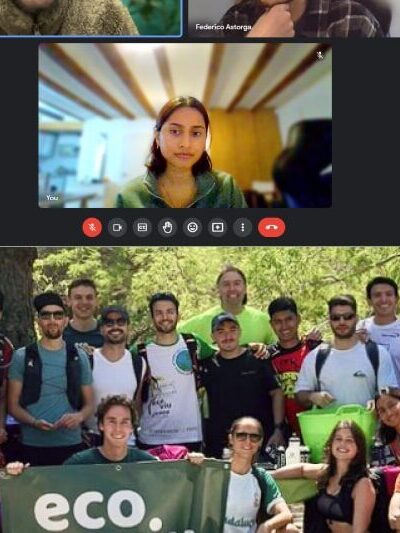Enabling personalized training to students who want to improve their English skills
| Client Learn to Learn | Project Duration 3 months (bootcamp) | Role UX/UI Designer in a team of 3 |
About the client
Learn to Learn's study resources assists users in overcoming language and cultural barriers.
Learn to Learn, a startup focused on enhancing English communication and fostering personal and professional growth, required an e-learning platform. I joined a 3-person UX team to develop an efficient e-learning experience in just 10 weeks.
The Problem
Students are unsatisfied with their current online classroom experience
The Challenge
How might we establish a platform with essential features for running an online classroom?
The Research Methods
During my efforts to understand the frustrations of online language learning, my research methods included user interviews with students from competitor platforms.

Research Conclusions
“Its harder with e-learning to follow up with the educator.”
-User of Competitor Platform
Through affinity mapping, we found that our diverse user base, who utilize various language learning platforms, value daily practice and feedback. They emphasize the importance of personalized attention, easy access to resources, daily corrections, and progress updates for effective language learning.
Ideation
Setbacks + A new direction for choosing solutions.
After a case full of brainstormed features for the platform, I decided to prioritize a minimum viable product (MVP) focused on a virtual classroom, task and resources sections, and a progress bar, addressing key student needs.
Through card sorting, we successfully prioritized features where both user and business needs aligned. This process resulted in features like Automated Interactive Lessons, Feedback Mechanisms, Efficient Data Collection, and Seamless Communication
Solutions
Easier Access to Feedback
Users in group classes found it challenging to track improvements and engage with teachers due to class size. They wanted a smoother post-class experience, including accessing tasks, submitting assignments, and participating in forums. Our solution enables seamless teacher follow-ups with qualitative feedback, along with easy access to class summaries and tasks.
Intuitive Digital Visual Aids
Users in group classes found it challenging to track improvements and engage with teachers due to class size. They wanted a smoother post-class experience, including accessing tasks, submitting assignments, and participating in forums. Our solution enables seamless teacher follow-ups with qualitative feedback, along with easy access to class summaries and tasks.
Efficient progress tracking
Users wanted an e-learning platform that simplifies engagement with teachers and progress tracking. Our solution provides insights into strengths, weaknesses, and accurate performance data after completing class activities.
Personalized and interactive learning
Users wanted an e-learning platform that simplifies engagement with teachers and progress tracking. Our solution provides insights into strengths, weaknesses, and accurate performance data after completing class activities.
Testing + Improvements
1. Providing more opportunities to take notes for further discussion
Based on a peer review, the dashboard structure appeared to be simple and not overwhelming, but it was noted that there were large elements with a significant amount of blank space. Some users felt that the design looked overly simplistic.
It was difficult for a non English speakers to follow the tasks assigned during testing as the terminology was not recognizable.
Introduced icons as a visual aid to help users easily locate their class materials. The icons act as a guide and provide a clear indication of where the users can access their learning resources.
2. Providing more opportunities to take notes for further discussion
One user shared their desire to take notes even after getting a correct answer to a question. They believed this would help them better remember important tips and information. I also added a reminder that the tip was automatically added during the activity, this would help them better track their progress and learning.
3. Opted for a less cluttered and more intuitive layout.
Users felt confused trying to navigate to their homework. I moved towards a more streamlined and simplified design with filtering features to easily find homework and reading archives.
Lessons Learned
Keep my ideas close, keep my user’s closer.
This was my first-ever UX project (Hooray)! More than the actual output, however- I’m immensely grateful to have been through an entire UX process so I can see what it’s actually like. On that note, a few things I’ve learned:
I've realized the importance of prioritizing research and problem identification in project planning. If I hadn’t missed out investigating current users of the LTL Service along with the general language school users, it would have significantly streamlined the process of framing the problem.
I've learned to strike a balance between high-fidelity (Hi-Fi) and low-fidelity (Lo-Fi) prototypes. While it's important to refine high-fidelity wireframes, I shouldn't overlook usability testing for low-fidelity prototypes. Both are essential for an effective design process.
I've learned the difference between UX and UI design. Tracking user behaviors is essential for shaping UX strategy. We invested time in UI based on assumptions.
I've discovered that establishing clear project goals and priorities is essential for shaping a focused MVP framework during our second round of ideation.
Next Steps
If I had more time...
Integrating a translation option for more inclusion: Since this platform was built for non English speakers, it was crucial to take into consideration more recognizable terminology as well as the option to translate in their language.
Track the usability and make updates: After having tested out the product with a decent user base, reiterating and updating certain features would be important.

